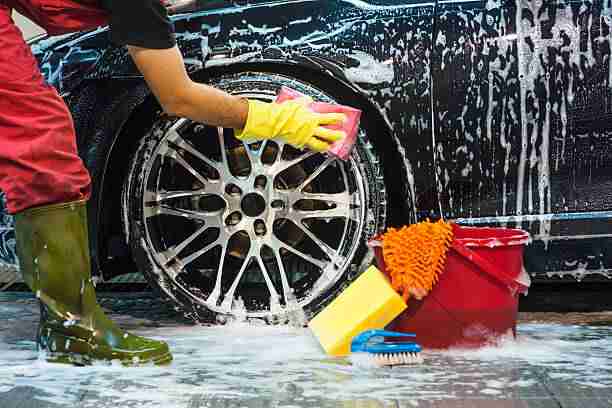
Washing your car at home can be a satisfying and cost-effective way to keep it looking its best. To achieve professional-level results, it’s important to use the right chemicals and tools. In this guide, we’ll cover the essential chemicals for a DIY car wash and explain how to use them for a clean, shiny vehicle.
1. Car Shampoo
Car shampoo is a must-have for any DIY car wash. It’s specially formulated to clean without harming your car’s paint or wax. Avoid using dish soap or household cleaners, as they can strip the protective wax layer. Look for a car shampoo that’s pH-balanced to ensure it’s gentle on your vehicle.
How to use: Dilute the car shampoo in a bucket of water according to the instructions on the bottle. Use a soft sponge or wash mitt to apply the soapy water to your car, working from the top down.
2. Wheel Cleaner
Your car’s wheels collect dirt, brake dust, and grime. A dedicated wheel cleaner helps remove these stubborn contaminants. Some wheel cleaners are acidic, while others are alkaline. Choose a wheel cleaner that suits your wheel type—avoid acidic cleaners for aluminum or delicate finishes.
How to use: Spray the wheel cleaner on your wheels and let it sit for a few minutes. Use a soft brush to scrub the wheels, paying attention to tight spaces. Rinse thoroughly with water to remove all residue.
3. Glass Cleaner
Clean windows are essential for safe driving and a polished look. A glass cleaner designed for automotive use is ideal, as it won’t leave streaks or damage tinted windows. Avoid ammonia-based cleaners if you have tinted windows, as they can cause damage.
How to use: Spray the glass cleaner on your windows and use a microfiber cloth to wipe them down. Work in small sections to prevent streaking. Wipe in straight lines for the best results.
4. Tire Dressing
Tire dressing gives your tires a deep black shine, enhancing your car’s appearance. It also helps protect the rubber from UV rays and cracking. Choose a water-based tire dressing for a natural look, or a silicone-based dressing for a glossy finish.
How to use: Apply the tire dressing to a foam applicator and spread it evenly over the tire’s sidewall. Avoid applying it to the tire’s tread, as it can make it slippery. Let it dry for a few minutes before driving.
5. Wax or Sealant
Wax or sealant provides a protective layer on your car’s paint, keeping it shiny and safe from environmental damage. Wax is typically made from natural carnauba, while sealant is synthetic. Both offer protection, but sealants tend to last longer.
How to use: Apply a small amount of wax or sealant to an applicator pad and spread it over your car’s paint in circular motions. Let it sit for a few minutes, then buff it off with a clean microfiber cloth. Work section by section for an even finish.
- Clay Bar A clay bar is a useful tool for removing embedded contaminants from your car’s paint. It helps create a smooth surface before waxing or sealing. Use a clay lubricant to prevent scratching while using the clay bar.
How to use: Spray the clay lubricant on your car’s paint and gently rub the clay bar over the surface. You’ll feel the clay pick up contaminants as you go. Keep the surface lubricated to prevent damage. Wipe off any residue with a microfiber cloth.
7. Interior Cleaner
Keeping your car’s interior clean is just as important as the exterior. An all-purpose interior cleaner is versatile and can be used on various surfaces, such as plastic, vinyl, and fabric. Choose a cleaner that’s gentle but effective at removing dirt and stains.
How to use: Spray the interior cleaner on a microfiber cloth and wipe down the surfaces inside your car. For tough stains, spray directly on the stain and scrub gently. Rinse with a clean, damp cloth to remove any residue.
In conclusion
A DIY car wash is a great way to maintain your vehicle and save money. With the right chemicals and tools, you can achieve professional-level results at home. Remember to use car-specific products to avoid damaging your vehicle, and always follow the instructions on the product labels. By using the essential chemicals covered in this guide, you’ll have a clean, shiny car that you’ll be proud to drive.